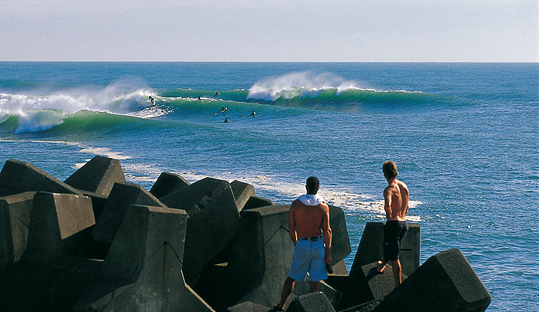Stormrider Guide to surfing Miyazaki, Kyushu
Japan, EAST ASIA
|
 , John Callahan
, John Callahan
|
Summary
|
+ Warm water typhoon swells
|
- Inconsistent swells
|
|
+ Less crowded pointbreaks
|
- Cold water days
|
|
+ Seagaia ocean dome
|
- Very expensive living costs
|
|
+ Japanese culture
|
- Communication difficulties
|
|
|
While not generally thought to be among JapanÕs top surfing destinations, MiyazakiÕs SE-facing shoreline is ideally located to catch typhoon swells. This coast is extensive and while the best waves do get crowded at times, there are lots of less accessible spots with good potential. Plenty of variety for surfers of all levels.
When to Go
Typhoons produce 4-6ft swells starting in July and climaxing in August-October. Occasional super-typhoons can deliver 12ft surf. They normally approach from the South China Sea before moving north usually accompanied by S winds. North Pacific lows as well as monsoonal NE winds produce some waves from November to February although good surf is rare despite dominant offshore winds. Winds often blow from the W-NE. Tidal range can reach 2.5m on spring tides and even more within deep bays, so get a tide table in a shop, and practice basic Japanese.
Surf Spots
Statistics |
J
|
F
|
M
|
A
|
M
|
J
|
J
|
A
|
S
|
O
|
N
|
D
|
| dominant swell |
E -NE |
E -NE |
E -NE |
E -SE |
E -SE |
E -SE |
| swell size (ft) |
2-3 |
2 |
1-2 |
2-3 |
3-4 |
3 |
| consistency (%) |
40 |
30 |
20 |
40 |
70 |
60 |
| dominant wind |
W -NE |
W -NE |
E -SW |
E -SW |
N -E |
W -NE |
| average force |
F4 |
F4 |
F3-F4 |
F3 |
F4 |
F4 |
| consistency (%) |
80 |
61 |
57 |
62 |
56 |
76 |
| water temp (C) |
18 |
17 |
22 |
27 |
25 |
21 |
| wetsuit |
3/2 |
3/2 |
springsuit |
boardshorts |
boardshorts |
springsuit |
|
Travel Information
Weather
Because of the warm Kuroshio Current, Kyushu experiences very different climate in winter and summer. Summers in Miyazaki are hot and humid with strong sunshine. Temps can exceed 30¡C (86¡F), even at night. May to August are really wet and prone to localised flooding. Autumn is warm and pleasant, the best time to visit unless a typhoon hits the coast (rare). Winter can be cold; but not often below freezing, snow is rare. Water feels tropical from July to October and doesnÕt drop much below 18¡C (64¡F) despite coldish winter days; take a light steamer and springsuit.
|
Lodging and Food
Most flats in the city are Japanese style: straw tatami mats on the floor, sliding shoji doors and a deep Ofuro (bathtub). A cheap Youth Hostel costs $50. A hotel like Kanko costs $90 (double). Seagaia Sheraton is $150 night (dble). Expect $20 for a meal at izakayas, udon, ramen and sushi shops.
|
Nature and Culture
DonÕt miss the Miyazaki shrine, Heiwadai Peace Park 37m tower built with stones collected from all over the world. Plenty of nightlife in Miyazaki. Seagaia Ocean Dome wave pool shut down in 2007.
|
|
